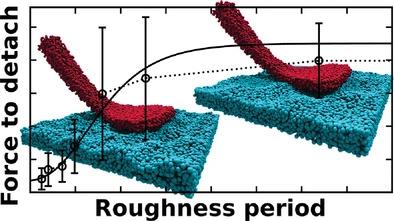Our official English website, www.x-mol.net, welcomes your feedback! (Note: you will need to create a separate account there.)
Gecko Adhesion on Flat and Rough Surfaces: Simulations with a Multi-Scale Molecular Model
Small ( IF 13.3 ) Pub Date : 2022-08-04 , DOI: 10.1002/smll.202201674 Tobias Materzok 1 , Danna De Boer 1 , Stanislav Gorb 2 , Florian Müller-Plathe 1
Small ( IF 13.3 ) Pub Date : 2022-08-04 , DOI: 10.1002/smll.202201674 Tobias Materzok 1 , Danna De Boer 1 , Stanislav Gorb 2 , Florian Müller-Plathe 1
Affiliation

|
A multiscale modeling approach is used to develop a particle-based mesoscale gecko spatula model that is able to link atomistic simulations and mesoscale (0.44 µm) simulations. It is used to study the detachment of spatulae from flat as well as nanostructured surfaces. The spatula model is based on microscopical information about spatulae structure and on atomistic molecular simulation results. Target properties for the coarse-graining result from a united-atom model of gecko keratin in periodic boundary conditions (PBC), previously developed by the authors. Pull-off forces necessary to detach gecko keratin under 2D PBC parallel to the surface are previously overestimated when only a small region of a spatula is examined. It is shown here that this is due to the restricted geometry (i.e., missing peel-off mode) and not model parameters. The spatula model peels off when pulled away from a surface, both in the molecular picture of the pull-off process and in the force-extension curve of non-equilibrium simulations mimicking single-spatula detachment studied with atomic force microscopy equipment. The force field and spatula model can reproduce experimental pull-off forces. Inspired by experimental results, the underlying mechanism that causes pull-off forces to be at a minimum on surfaces of varying roughnesses is also investigated. A clear sigmoidal increase in the pull-off force of spatulae with surface roughness shows that adhesion is determined by the ratio between spatula pad area and the area between surface peaks. Experiments showed a correlation with root-mean-square roughness of the surface, but the results of this work indicate that this is not a causality but depends on the area accessible.
中文翻译:

壁虎在平坦和粗糙表面上的粘附:多尺度分子模型的模拟
多尺度建模方法用于开发基于粒子的中尺度壁虎铲模型,该模型能够将原子模拟和中尺度 (0.44 µm) 模拟联系起来。它用于研究刮刀从平面和纳米结构表面的分离。刮刀模型基于刮刀结构的微观信息和原子分子模拟结果。粗粒化的目标属性来自作者先前开发的周期性边界条件 (PBC) 中壁虎角蛋白的联合原子模型。当仅检查刮刀的一小部分区域时,之前高估了在平行于表面的 2D PBC 下分离壁虎角蛋白所需的拉力。这里表明这是由于几何形状受限(即缺少剥离模式)而不是模型参数。刮刀模型在拉离表面时会剥落,无论是在剥离过程的分子图像中,还是在模拟使用原子力显微镜设备研究的单刮刀分离的非平衡模拟的力-延伸曲线中。力场和抹刀模型可以再现实验拉断力。受实验结果的启发,还研究了在不同粗糙度的表面上导致拉脱力最小的潜在机制。刮刀的拉离力随表面粗糙度的明显 S 形增加表明粘附力由刮刀垫面积与表面峰之间的面积之比决定。实验表明与表面的均方根粗糙度相关,
更新日期:2022-08-04
中文翻译:

壁虎在平坦和粗糙表面上的粘附:多尺度分子模型的模拟
多尺度建模方法用于开发基于粒子的中尺度壁虎铲模型,该模型能够将原子模拟和中尺度 (0.44 µm) 模拟联系起来。它用于研究刮刀从平面和纳米结构表面的分离。刮刀模型基于刮刀结构的微观信息和原子分子模拟结果。粗粒化的目标属性来自作者先前开发的周期性边界条件 (PBC) 中壁虎角蛋白的联合原子模型。当仅检查刮刀的一小部分区域时,之前高估了在平行于表面的 2D PBC 下分离壁虎角蛋白所需的拉力。这里表明这是由于几何形状受限(即缺少剥离模式)而不是模型参数。刮刀模型在拉离表面时会剥落,无论是在剥离过程的分子图像中,还是在模拟使用原子力显微镜设备研究的单刮刀分离的非平衡模拟的力-延伸曲线中。力场和抹刀模型可以再现实验拉断力。受实验结果的启发,还研究了在不同粗糙度的表面上导致拉脱力最小的潜在机制。刮刀的拉离力随表面粗糙度的明显 S 形增加表明粘附力由刮刀垫面积与表面峰之间的面积之比决定。实验表明与表面的均方根粗糙度相关,



























 京公网安备 11010802027423号
京公网安备 11010802027423号